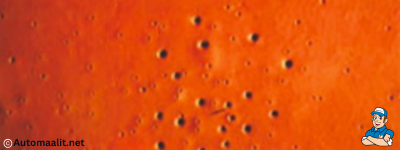Pinholes: Small pits the size of a needle head or leather-like pores appear on the surface from top to bottom.
Description:
Pinholes are primarily caused by solvent or moisture trapped under the surface layer without the chance to evaporate.
Cause:
- Excessively thick paint layers and insufficient drying time.
- Air trapped in filler, forming pinholes after sanding.
- Incorrect choice of thinner, such as improper mixing ratio, poor quality, or unsuitable drying time.
- Improper cleaning or preparation of the substrate, leading to moisture retention and pinholes during the evaporation process.
- Inappropriate spraying techniques, such as incorrect spray gun settings or too short a distance to the painted surface.
- Insufficient drying, sudden heating, or overly rapid external drying.
- Excessively high temperature of the substrate being worked on.
Repair:
- Sand through the filler, fill the pinholes, and repeat the necessary filling work. Sand the surface smooth and repaint.
- Use a scraper vertically to the working surface and apply primer very thinly to ensure the pinholes are covered. Also, make sure the scraper does not peel off the primer during the motion.



